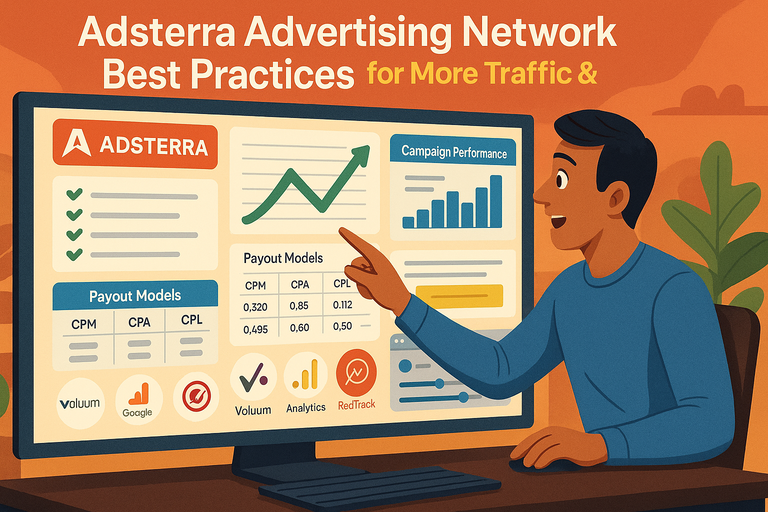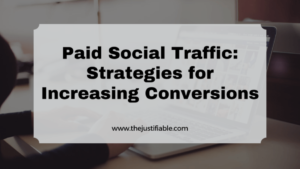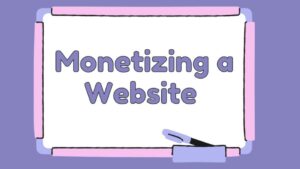Table of Contents
The Adsterra advertising network has become one of the go-to platforms for publishers and marketers aiming to boost both traffic and revenue. But with so many ad formats, targeting options, and optimization techniques available, how do you actually make the most of it?
Whether you’re just starting out or already have campaigns running, understanding how to fine-tune your Adsterra strategy can make the difference between average results and exceptional performance.
This guide will walk you through the proven best practices to help you get the most out of your Adsterra campaigns—covering everything from setup to scaling and revenue optimization.
Setting Up Adsterra the Right Way for Success
Getting started with the Adsterra advertising network isn’t just about plugging in some ads and hoping for the best. It’s about setting a solid foundation that helps your campaigns scale with clarity and purpose.
Let’s walk through the first steps I recommend when setting up your Adsterra account for success.
Choosing the Best Ad Formats for Your Audience
Adsterra offers multiple ad formats—Popunders, Social Bars, Display Banners, In-Page Push, and Native Ads. Each behaves differently, and choosing the right one depends on your traffic type and user behavior.
For example:
- Popunders (open under a user’s current tab) work great for high-volume entertainment or file-sharing sites.
- In-Page Push Ads blend into content and convert better for lifestyle, gaming, and finance niches.
- Social Bar Ads—floating, customizable widgets—are excellent for mobile traffic since they’re interactive and less intrusive.
I suggest starting with two to three formats, then tracking which ones deliver the highest CTR (click-through rate) and conversions. You can do this by visiting Dashboard → Statistics → Ad Format Comparison inside Adsterra’s UI.
From my experience, mixed-format testing is the quickest way to find your “sweet spot” audience match.
Optimizing Ad Placement for Maximum Engagement
Where you place your ads on your site (or app) is just as important as which format you choose. The goal is to position ads where users naturally pause or engage—without being annoying.
Here’s what usually works best:
- Above the fold placements: These grab attention immediately, especially for banners or native ads.
- Mid-content placements: In-article ads often deliver higher engagement since users are already interested in the topic.
- Exit or time-triggered ads: Adsterra allows you to trigger popunders or social bars when a user is about to leave—perfect for retargeting interest.
Try to balance visibility and user experience. I advise using tools like Hotjar or Microsoft Clarity to see where users scroll and click most, then refine placements accordingly.
Understanding Payout Models: CPM, CPA, and CPL
Adsterra supports multiple payout models, and knowing the difference helps you align your goals with how you earn.
- CPM (Cost per Mille): You’re paid per 1,000 impressions—best for high-traffic publishers.
- CPA (Cost per Action): You earn when users perform a specific action (like signing up or installing an app).
- CPL (Cost per Lead): Similar to CPA, but focused on collecting leads such as email signups.
If you’re an advertiser, choosing the right model depends on your campaign goal. For example, if you want brand awareness, CPM makes sense. But if you’re focused on conversions, CPA or CPL is smarter.
Adsterra’s dashboard conveniently shows your earnings breakdown by model under “Statistics → Payment Type.” I recommend experimenting with hybrid campaigns—running both CPM and CPA—to find your most profitable mix.
Creating High-Converting Landing Pages for Adsterra Traffic
A poor landing page can ruin even the most well-optimized ad campaign. Your landing page is where curiosity becomes conversion.
Here’s a simple structure that usually works:
- Catchy Headline: Directly reflects your ad’s promise.
- Visual Hook: Use an image, short video, or GIF relevant to your offer.
- Simple CTA: Make it clear and easy to act—like “Get Started” or “Claim Offer.”
If you’re running Adsterra Popunder traffic, make sure your page loads fast (under 3 seconds). I suggest using PageSpeed Insights to test. For mobile, responsive design isn’t optional—it’s crucial.
I’ve found that removing unnecessary navigation links can increase conversion rates by 10–15%. Keep users focused on one action only.
Proven Targeting Strategies to Drive Quality Traffic

Targeting in Adsterra is where the real optimization begins. Smart targeting ensures your ads reach the right audience at the right time, leading to higher conversions and lower wasted spend.
Using Geo-Targeting and Device Targeting to Refine Campaigns
Adsterra’s targeting system lets you choose by country, city, device, OS, and browser. For example, if you’re promoting a mobile app, you might target Android users in India where install costs are lower but traffic quality remains strong.
I usually start broad, then narrow down after analyzing performance in Statistics → GEO & Device Reports.
Top tip: Avoid running one campaign globally. Instead, duplicate campaigns by region to fine-tune bids and creatives for each market.
Leveraging Traffic Type: Direct, Popunder, and Social Sources
Different traffic types yield different engagement levels.
- Direct traffic (users typing or bookmarking your site) gives high intent and often better ROI.
- Popunder traffic delivers large volumes but needs strong creatives.
- Social sources—traffic from Adsterra’s Social Bar—perform well for mobile and app-based offers.
I suggest checking traffic type reports inside the Traffic Chart section to see what’s converting best. Adjust budgets based on actual conversion data rather than assumptions.
Segmenting Audiences Based on Behavior and Intent
Segmentation helps you match messages to user intent. You can segment by:
- Returning vs. new users
- Referral source
- Time spent on site
For example, if users spend less than 10 seconds on your landing page, that’s a sign your offer isn’t matching their intent. Use this data to tweak ad creatives or change targeting filters.
Behavioral segmentation turns generic campaigns into personalized experiences—and personalization almost always leads to higher CTRs.
A/B Testing Ad Creatives to Identify Winning Variations
Testing isn’t optional; it’s the backbone of performance marketing. Adsterra allows you to easily clone campaigns and change one variable at a time.
Test different elements like:
- Headline or CTA text
- Image or color scheme
- Ad format or landing page layout
Start small—two versions at most—and let them run for a few thousand impressions. Once you find a winner, scale it, but keep testing. Even minor creative tweaks can raise conversions by 20% or more.
Optimizing Campaign Performance for Better ROI
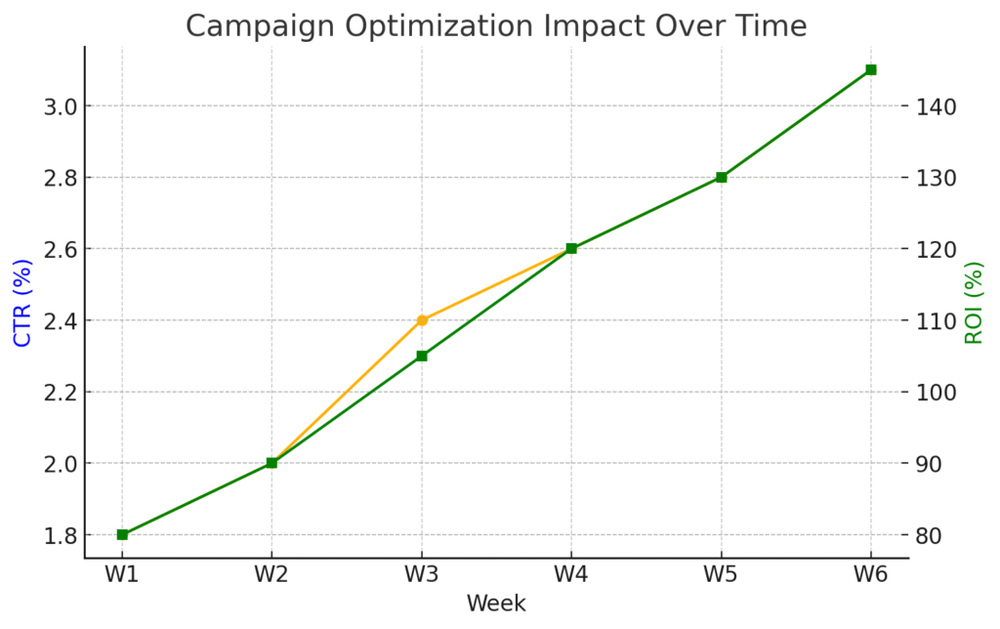
Once your campaigns are live, optimization becomes a daily habit. The Adsterra advertising network gives you plenty of data, but it’s your job to turn that data into insights.
Tracking Key Metrics Inside Adsterra Dashboard
Inside your dashboard, you’ll find performance metrics like impressions, clicks, conversions, CTR, and eCPM. The most critical ones for measuring ROI are CTR (click-through rate) and CR (conversion rate).
Check your stats daily under Dashboard → Statistics → Campaign Performance.
If CTR is high but conversions are low, it usually means your ad creative is strong, but the landing page or offer isn’t aligned.
Using Third-Party Tracking Tools for Deeper Insights
While Adsterra provides strong analytics, pairing it with tools like Voluum, Binom, or RedTrack gives you deeper insight. You can track user paths, conversion funnels, and even detect fraud traffic sources.
In Voluum, for example, you can integrate Adsterra via API and tag your campaigns by ad format, GEO, and placement ID. This way, you’ll know exactly which combinations generate profit—and which ones waste spend.
Adjusting Bids and Budgets for Smarter Spending
Adsterra’s bidding system rewards balance, not aggression. I advise starting at the platform’s suggested minimum bid, then increasing gradually for top-performing zones.
To find them: go to Statistics → Zone Report and sort by conversion rate. Pause or bid down zones with poor performance, and scale up winners.
Remember: Increasing your bid slightly (even by 10%) can boost your position dramatically due to competition thresholds.
Recognizing and Eliminating Low-Performing Traffic Sources
Every campaign will have underperforming placements. The trick is spotting them early.
Inside Adsterra’s zone report, you can blacklist low-quality zones manually. Export your stats weekly, analyze with Excel or Google Sheets, and block zones with:
- CTR under 0.05%
- Conversion rate below 1%
- eCPM significantly lower than average
Consistent pruning keeps your budget focused on what works—and in performance marketing, focus equals profit.
Expert Tip: The Adsterra advertising network rewards consistency. Don’t chase instant wins; instead, treat every campaign as an experiment. Analyze, adjust, repeat. That’s how you transform traffic into long-term revenue.
Start optimizing for higher ROI today. Launch your Adsterra campaign and scale smarter.
Monetization Strategies for Publishers on Adsterra
Monetizing your website with the Adsterra advertising network can be a powerful way to turn traffic into steady income.
But earning consistently takes more than simply pasting ad codes—it’s about smart placement, diversified monetization, and maintaining a smooth user experience.
I’ll walk you through what’s worked best for me and many experienced publishers I’ve spoken with.
Best Ad Placement Strategies for Website Monetization
Ad placement can make or break your revenue. The sweet spot is balancing visibility with user comfort—ads should be seen, not screamed.
Here’s what tends to perform best across most niches:
- Above the fold: Placing an ad near the top of your page grabs immediate attention, especially banners or native ads.
- In-content ads: These are inserted within your articles, where user attention is already focused. They often bring higher CTRs than sidebar placements.
- Exit-intent popunders: Adsterra’s popunder ads, triggered when users are about to leave, can be surprisingly effective for monetizing bounced traffic.
You can easily set placement rules in your Adsterra dashboard under Webmaster → Websites → Create Ad Unit, choosing placement zones based on traffic type. I suggest testing two or three positions at once and tracking CTR and eCPM to find your most profitable layout.
In one test I ran on a tech blog, moving a 300×250 ad block from the sidebar to in-content boosted CTR by nearly 40%—proof that visibility and context truly matter.
Combining Adsterra with Other Revenue Channels
It’s rarely wise to rely on a single income stream. While Adsterra can handle most of your monetization, combining it with complementary networks can maximize yield.
You might:
- Use Adsterra Popunders alongside Google AdSense display ads for layered monetization.
- Add affiliate links within your content for niche offers.
- Integrate native ad widgets like Taboola or MGID for extra exposure.
Adsterra’s technology is built to work alongside others—you won’t face conflicts or policy issues as long as placements don’t overlap or interfere with user clicks.
A small but practical tip: Track all ad channels separately in Google Analytics using UTM tags, so you can see which combination drives the most revenue per session.
Improving Site Speed and UX to Boost Ad Revenue
Here’s a truth I learned the hard way: a slow website quietly kills your earnings. Every extra second your site takes to load, your bounce rate increases—and fewer views mean fewer impressions.
You can improve performance without losing ad income by:
- Compressing images with TinyPNG or ShortPixel.
- Using a CDN (Content Delivery Network) like Cloudflare to speed up delivery.
- Limiting the number of heavy ad scripts loading at once—two or three is usually enough.
Adsterra ads load asynchronously, meaning they don’t block your page’s main content, but it’s still good practice to check performance in Google PageSpeed Insights.
From my experience, optimizing speed from 5s to under 3s can raise impressions by 10–15%—a free revenue boost just by improving user experience.
Avoiding Common Mistakes That Reduce Earnings
Many publishers unintentionally hurt their own income by skipping the basics. Here are the big pitfalls to avoid:
- Overloading pages with ads: Too many ad blocks overwhelm users and lower engagement.
- Ignoring mobile optimization: More than 60% of Adsterra traffic is mobile; if your layout breaks, your earnings drop.
- Not tracking performance: Guessing what works wastes potential. Always check Statistics → Sites → Zone Report to see which placements earn most.
- Using irrelevant ad formats: A gaming site shouldn’t rely on native news widgets—context matters.
I always recommend a “less is more” approach: optimize your top 3 placements, then expand once those consistently perform.
Creative Optimization Techniques That Convert
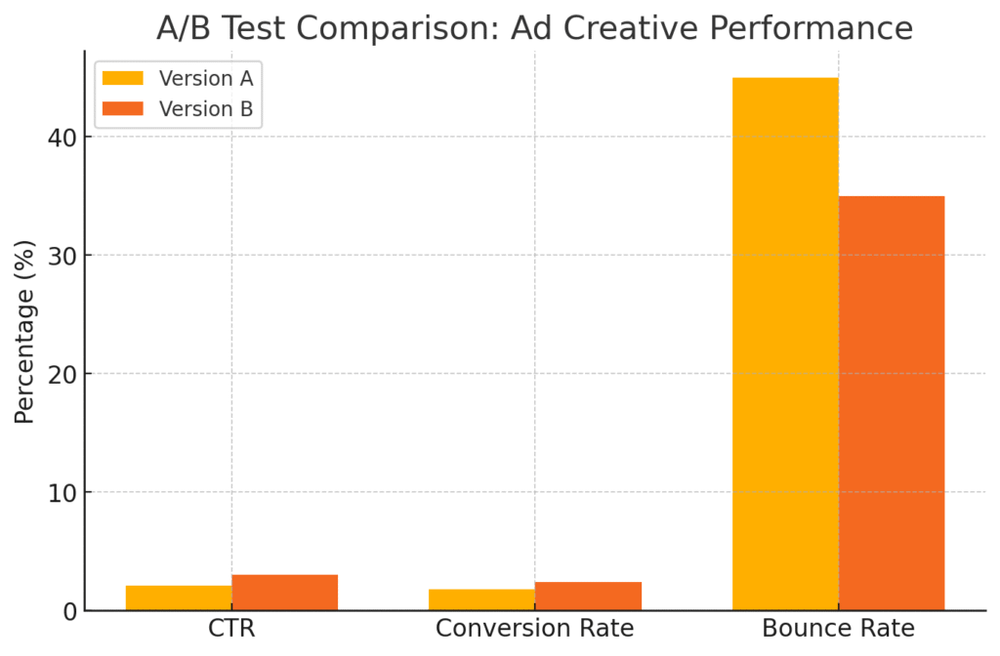
Even the best ad formats can fall flat if your creatives (the actual ad visuals and text) fail to connect with your audience. This is where creativity meets data.
The Adsterra advertising network rewards advertisers who constantly test and refine their creative approach.
Writing Compelling Ad Copy That Captures Attention
Good ad copy doesn’t shout; it speaks directly to your reader’s curiosity. The goal is to make users think, “This looks interesting—I’ll click.”
Here’s a simple formula I like to use: [Problem] + [Emotional Hook] + [Solution/Offer].
For example, instead of writing “Download this app now!”, try “Bored on your commute? This free app turns minutes into rewards.”
Keep it conversational and benefit-focused. Adsterra allows short, punchy text, so clarity wins over cleverness.
If you’re targeting multiple regions, localize your copy. I’ve seen conversion rates double just by translating offers into the target language.
Designing Eye-Catching Visuals for Higher CTR
Visuals are the first thing users notice—before they even read your copy. Aim for high contrast, emotion, and simplicity.
Some quick creative design principles:
- Use faces and expressions—they attract attention instantly.
- Avoid cluttered images or text-heavy graphics.
- Stick to bright, high-contrast colors that stand out on both light and dark backgrounds.
Tools like Canva or VistaCreate can help you design fast without hiring a designer.
A small test I ran with Adsterra’s Social Bar ads found that switching from stock photos to illustrated icons increased CTR by 22%. People crave authenticity over generic visuals.
Testing Multiple Headlines and CTAs for Better Engagement
Adsterra’s platform makes it easy to test different ad versions. When setting up your campaign, you can create several creatives under the same ad group and track their CTRs side-by-side.
Try varying:
- Headlines (urgent vs. curious tone)
- CTA text (“Join Free” vs. “Start Earning Today”)
- Image styles (real-life vs. graphic)
The key is not to test everything at once. I usually start by testing headlines first, then move on to visuals. Small tweaks often create huge differences—sometimes even doubling engagement.
Using Ad Frequency and Timing to Avoid Fatigue
Ad fatigue happens when users see the same creative too often and tune it out. To prevent this, rotate creatives every 7–10 days and limit frequency caps.
In Adsterra, you can do this easily by going to Campaign → Settings → Frequency Capping. I recommend capping impressions at 3–4 per user per day for most formats.
If performance starts dropping even with a good CTR, it’s time to refresh. This keeps your audience engaged without overspending.
Ensuring Compliance and Maintaining Account Health
The Adsterra advertising network maintains a strong reputation partly because it enforces strict compliance policies. Staying on the right side of those rules protects both your revenue and your account.
Following Adsterra’s Policy Guidelines to Prevent Bans
Before launching any campaign or ad placement, review Adsterra’s official Terms and Conditions inside your dashboard. Common violations include promoting restricted content (like adult, malware, or deceptive offers).
Always verify offers from affiliate networks to ensure they comply. If you’re unsure, you can reach out to your Adsterra account manager for a quick review—something I highly recommend before scaling.
Avoiding Fraudulent Traffic and Click Manipulation
Fraudulent traffic—fake clicks or bot-generated impressions—can get your account flagged fast. If you’re buying traffic externally, make sure it’s from verified sources only.
Adsterra automatically detects anomalies, but you can help by checking your Traffic Quality Report. If you notice sudden spikes in clicks without conversions, pause that source immediately.
Using Google reCAPTCHA on your site also helps filter bot traffic, keeping your stats clean and trustworthy.
Maintaining Transparency Between Advertisers and Publishers
Transparency builds trust within the Adsterra ecosystem. If you’re a publisher, accurately describe your site’s content and traffic sources when registering. Misrepresenting your site can lead to ad mismatches or account issues.
Advertisers, on the other hand, should clearly define offer restrictions and landing page behavior. The more transparent you are, the smoother your campaigns will run.
Keeping Campaigns Ethical While Scaling Revenue
Here’s my golden rule: if a tactic feels manipulative, it probably is. Avoid misleading CTAs like “You’ve won!” or fake system alerts. They might boost CTR temporarily but destroy long-term trust—and Adsterra will catch them.
Focus instead on relevance and genuine value. A well-targeted, honest ad campaign will always outperform a clickbait one in the long run.
Advanced Tips to Scale Campaigns and Earnings
Scaling your campaigns on the Adsterra advertising network isn’t about spending more—it’s about spending smarter. Once you’ve nailed the basics, scaling is where you transform consistent results into exponential growth.
It’s a gradual, data-driven process that combines automation, smart optimization, and creative diversification.
Using Automation and Smart Optimization Tools
Manual optimization can only take you so far. Once campaigns start scaling, automation becomes your best ally. Adsterra’s Smart CPM feature automatically adjusts your bids to achieve the best balance between impressions and conversions.
Here’s how I usually do it:
- Go to Campaigns → Settings → Smart CPM and set your target eCPM (the effective cost per 1,000 impressions).
- Let the algorithm optimize bids based on real-time performance data.
- Revisit the results every 48–72 hours and adjust if needed.
If you’re using third-party tracking platforms like RedTrack or Voluum, integrate them with Adsterra’s API. These tools can automate pausing low-performing zones or scaling profitable ones instantly—saving hours of manual work daily.
I advise starting small with automation: let it handle bidding and zone blocking first, then expand to creative rotation and budget allocation once you’re comfortable reading the results.
Building Long-Term Strategies Around High-Performing Offers
Once you’ve identified offers that consistently convert, the real magic is in building long-term systems around them.
Here’s a strategy I use:
- Identify top offers by checking Adsterra’s conversion reports under Statistics → Campaign Performance.
- Create dedicated funnels for those offers with custom landing pages optimized for each GEO or device.
- Negotiate better payouts with your affiliate managers once you can prove volume.
Think of your top-performing offers as “evergreen assets.” They’re not one-off wins but stable income engines that can keep generating revenue month after month.
Analyzing Seasonal Trends to Adjust Campaign Timing
Ad performance often fluctuates with the seasons, holidays, and global events. For example, gaming and e-commerce offers usually skyrocket during Q4 (October–December), while finance or utility apps perform better early in the year.
Inside Adsterra, you can check traffic availability and rate trends in your Advertiser Dashboard → Market Insights. Combine this with Google Trends to understand when demand peaks in your niche.
Here’s what I suggest:
- Scale aggressively before known peaks (e.g., Black Friday).
- Lower bids slightly during slow months but keep campaigns active to maintain data flow.
- Prepare fresh creatives and offers 2–3 weeks before seasonal surges hit.
Being proactive rather than reactive during trend shifts can increase ROI by up to 30%, based on what I’ve seen in multiple campaigns.
Expanding to Multiple Ad Formats for Cross-Channel Growth
Adsterra’s diverse ad formats allow you to reach users across multiple touchpoints. Don’t limit yourself to one format—expand strategically.
For instance:
- Start with Popunder or Social Bar for fast traffic testing.
- Layer in Native Ads for long-term engagement.
- Experiment with In-Page Push for retargeting mobile users.
Each format serves a different stage in the conversion funnel. I’ve often found that running the same offer through two complementary formats—say, Popunder plus Native—can raise total conversions by 20–40%.
You can track performance across formats by grouping them in your campaign view under Statistics → Ad Format Comparison.
Tracking, Testing, and Continuous Improvement
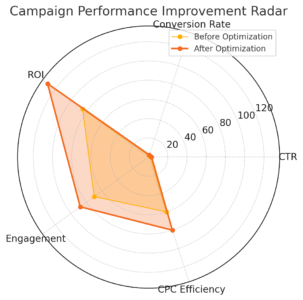
Optimization isn’t a one-time process—it’s an ongoing habit. Every successful advertiser I know treats data as their most valuable currency.
Using Analytics to Identify Performance Gaps
Start by checking your Adsterra dashboard daily. The key metrics to monitor include:
- CTR (Click-Through Rate): Are your creatives engaging enough?
- CR (Conversion Rate): Are your landing pages aligned with user intent?
- eCPM and ROI: Are you earning enough per impression to stay profitable?
If CTR is high but CR is low, your ads attract attention but don’t convert. If both are low, revisit your targeting or creatives.
I often export my reports to Google Sheets to visualize trends—spikes, dips, or sudden performance shifts usually reveal hidden opportunities.
Regularly Refreshing Creatives to Maintain Engagement
Audiences burn out quickly. Even the best-performing ads lose effectiveness after repeated exposure. That’s why refreshing creatives regularly keeps performance strong.
I recommend updating visuals or headlines every 10–14 days, especially for Popunder or Social Bar formats.
To make this easier, create a creative bank—a folder with 10–15 variations of headlines, images, and CTAs. That way, you always have fresh material ready to rotate in.
It might sound tedious, but even small updates—like changing button color or tweaking phrasing—can improve CTR by 15–25%.
Learning from Data to Refine Future Campaigns
Every failed test contains a lesson. Instead of discarding underperforming campaigns, I study them closely.
Ask yourself:
- Which GEOs or placements underperformed, and why?
- Did certain creatives attract clicks but fail to convert?
- Were there technical issues on landing pages (slow loading, poor mobile design)?
Documenting these insights builds your internal “playbook” of what works. Over time, you’ll start noticing repeat patterns that make future optimization faster and more intuitive.
Creating a Long-Term Optimization Plan for Sustainable Growth
Short-term results are easy. The real challenge is sustaining performance month after month.
Here’s how I approach it:
- Set weekly optimization goals: e.g., improve CTR by 10% or lower CPA by 15%.
- Track progress visually: A simple chart or dashboard view helps spot progress or declines early.
- Review every 30 days: Identify top-performing offers, GEOs, and ad formats to focus your next month’s budget.
This structured approach prevents burnout and ensures steady, compound growth over time.
Expert Insights and Pro Tips for Adsterra Users
Over the years, I’ve seen certain habits separate average advertisers from high-ROI marketers. Let’s pull back the curtain on what truly makes a difference when using the Adsterra advertising network.
How Top Marketers Achieve High ROI on Adsterra
High-ROI advertisers share three habits:
- They obsess over data. Every decision—from creative design to GEO targeting—is data-backed.
- They test methodically. One change at a time, so they know exactly what moved the needle.
- They reinvest profits. Instead of cashing out early, they scale winning campaigns to multiple formats and markets.
A simple rule I follow: don’t scale what you can’t measure. Always confirm consistent ROI for at least 5–7 days before increasing spend.
Avoiding the Most Common Pitfalls in Campaign Management
Many new Adsterra users fall into the same traps:
- Launching too many campaigns at once.
- Ignoring performance metrics after setup.
- Overbidding too early without sufficient data.
Start small, test fast, and scale deliberately. Adsterra’s interface makes it easy to track each campaign in Dashboard → Campaign Summary. Use those insights daily—it’s the best way to avoid rookie mistakes.
Practical Budgeting Techniques for Consistent Profits
Budget allocation determines how fast (and safely) you can grow. I usually follow the 70/20/10 rule:
- 70% on proven campaigns.
- 20% on testing new offers or creatives.
- 10% reserved for experimentation with new GEOs or ad formats.
This keeps revenue flowing while giving you room to explore. If a test campaign hits, you can shift budget immediately without disrupting your main income stream.
Scaling from Small Campaigns to Enterprise-Level Advertising
Scaling isn’t about size—it’s about structure. Once you reach consistent profitability, start building systems.
You can:
- Use dedicated tracking tools for multi-channel campaigns.
- Hire a virtual assistant for reporting and data cleanup.
- Automate daily optimizations through scripts or integrations.
Think of yourself as an ad operations manager, not just a marketer. Your job is to build repeatable processes that grow without constant micromanagement.
Final Takeaways: Turning Adsterra Into a Revenue Engine
When used strategically, the Adsterra advertising network can become a long-term, scalable revenue machine. But success depends on patience, precision, and constant curiosity.
Key Metrics That Indicate Long-Term Growth
Keep your eyes on metrics that signal sustainable performance:
- eCPM: Reflects ad efficiency and revenue potential.
- ROI: Your bottom-line profitability indicator.
- Conversion consistency: Regular conversions show campaign stability.
These numbers tell the story of your business health more than daily profit spikes ever could.
The Importance of Experimentation and Adaptation
Digital advertising evolves fast. What works today might fade tomorrow. That’s why I recommend treating your campaigns as living systems—constantly adapting, learning, and improving.
Experiment often, but intelligently. Document results, test new ad formats, and stay curious about trends within Adsterra’s community and blog.
Building a Sustainable Strategy Around Adsterra
Long-term success means balancing revenue with reputation. Avoid aggressive monetization that hurts user trust. Instead, focus on steady, ethical growth by offering genuine value through relevant ads and clean site experiences.
The most profitable publishers I know are the ones who think in years, not weeks.
How to Keep Evolving With Digital Advertising Trends
Stay ahead by reading Adsterra’s product updates and following industry news on AdExchanger, HubSpot, or Marketing Brew.
Every time Adsterra rolls out a new feature—like improved targeting or a new ad format—test it early. Early adopters often gain an edge before competition floods in.


